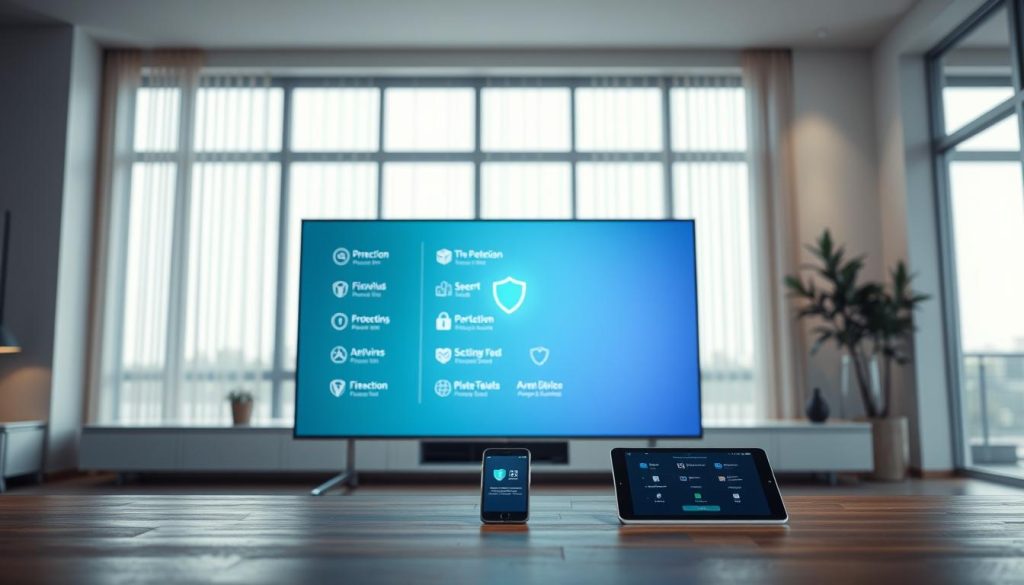Smart TVs and streaming devices are key for our entertainment. But, they can also face cyber threats. Malware and spyware can harm these devices, risking our personal data.
Automated attacks are on the rise, making IoT devices a big concern. Smart TVs and streaming devices are often targeted by IoT Botnets. This shows we need strong IoT security measures.
To keep your devices safe, it’s important to take action. Make sure your software is always updated and use strong passwords. These steps can greatly lower the chance of your devices being hacked.
Key Takeaways
- Smart TVs and streaming devices are vulnerable to malware and spyware.
- IoT Botnets can exploit these devices, compromising personal data.
- Implementing robust IoT security measures is crucial.
- Keeping software up-to-date and using strong passwords can help secure devices.
- Being aware of the risks can help you protect your smart devices.
Understanding Malware & Spyware in Smart TVs
Smart TVs and streaming devices are now key parts of our entertainment. They bring new risks to our homes. These devices offer streaming and internet browsing, making them targets for malware and spyware.
What Are Smart TVs & Streaming Devices?
Smart TVs and streaming devices are internet-connected devices. They let users watch movies, TV shows, and music online. Examples include smart TVs with Wi-Fi, Roku, Amazon Fire TV, and Google Chromecast, and gaming consoles for streaming.
- Roku Streaming Devices
- Amazon Fire TV
- Google Chromecast
- Smart TV platforms like Tizen and WebOS
How They Connect to the Internet
These devices use Wi-Fi or Ethernet to connect to the internet. This lets them stream services, download apps, and get updates. They offer features like voice control and personalized content.
Why They’re Vulnerable to Malware
Their internet connection makes them vulnerable to threats. Weak passwords, outdated software, and system vulnerabilities can be exploited. IoT botnet attacks can turn these devices into bots for DDoS attacks or spreading malware.
To keep your devices safe, update their software regularly. Use strong passwords and be careful with new app installations or links.
Recent Cases of Malware Attacks
In recent years, malware attacks have increased on smart TVs and streaming devices. These attacks expose serious security flaws. They not only harm the devices but also threaten users’ privacy.
Case Study: The Tizen Operating System Vulnerability
The Tizen operating system, found in Samsung smart TVs, has faced malware attacks. Hackers have found ways to get into these devices because of its weaknesses.
- Vulnerability Exploitation: Hackers have used different tactics to take advantage of Tizen OS flaws. This includes zero-day attacks that exploit unknown weaknesses.
- Impact on Users: These attacks can give hackers access to private info. This includes viewing history and personal details.

Amazon Fire TV Malware Incident
Amazon Fire TV devices have also been hit by malware. These incidents often involve malicious apps that harm device security.
- These apps seem real but actually contain malware. They can steal user data or disrupt device functionality.
- Users are tricked into downloading these apps. This shows the need for user education on safe app installation.
Impact of Malware on Users’ Privacy
Malware can have a big impact on users’ privacy. It can steal personal data, like login details and viewing habits.
- Data Theft: Malware can collect sensitive user data without permission. This data can be used for bad things.
- Privacy Invasion: Malware can also let hackers monitor user activity. This invades users’ privacy.
To protect against these threats, keep your devices updated and use strong, unique passwords. Also, regularly check the apps you have installed. Being careful with app permissions can help secure your smart TV and streaming devices.
Recognizing the Signs of Infection
Smart technology is everywhere, making it key to know how to spot malware and spyware. Smart TVs and streaming devices are convenient but come with risks. It’s important to stay alert to these dangers.
Common Symptoms of Malware & Spyware
Malware and spyware can show up in different ways on your devices. Look out for unusual behavior like apps crashing or freezing. Also, watch for unfamiliar apps or icons popping up, and increased data usage without a reason.
Your device might heat up too much or battery drain faster than usual. This is especially true for mobile devices, but it can happen with any device.
How to Detect Malicious Software
To find malicious software, be vigilant and use the right tools. Keep an eye on your device’s performance and behavior. Look for any signs of trouble.
Using IoT security measures like antivirus software for smart devices helps a lot. Make sure the security software fits your device.
Step-by-Step: Checking for Infections
To check your smart TV or streaming device for infections, follow these steps:
- Review installed apps: Check for apps you don’t know or use.
- Check for software updates: Keep your device and apps up to date.
- Run a security scan: Use antivirus software to scan for malware.
- Reset to factory settings: If you think it’s seriously infected, reset it to factory settings.
By following these steps, you can lower the risk of your devices getting hacked. This helps keep your IoT security strong.
Protecting Your Smart TV from Malware
To keep your smart TV safe, you need to follow some important steps. It’s key to know how to protect it in today’s world. This way, you can enjoy your TV without worry.
Best Practices for Secure Usage
Using your smart TV safely is crucial. Be careful when adding new apps. Some might harm your device. Always check the app’s permissions before installing.

Regular Software Updates
Keeping your smart TV updated is essential. Updates fix bugs and close security holes. Enable automatic updates if you can. This way, your TV stays safe without you needing to check for updates.
Importance of Strong Passwords
Strong passwords are vital for your smart TV’s security. Weak passwords can let hackers in. Use letters, numbers, and special characters in your password. Also, think about using a password manager.
By following these tips, you can lower the chance of malware. This keeps your data safe and your viewing experience worry-free.
Popular Security Solutions for Smart TVs
It’s key to know the security options for smart TVs and streaming devices. With more devices connected at home, cyber threats grow.
Effective IoT security measures are vital to protect smart TVs from malware and spyware. They keep your device and personal data safe.
Top Antivirus Software Recommendations
Antivirus software is a must for smart TV security. Here are some top picks:
- Norton Antivirus
- Kaspersky Smart Security
- Avast Smart Security
These tools offer real-time protection against malware and threats. They help safeguard connected devices.

Firewalls for Streaming Devices
Firewalls block harmful internet traffic and unauthorized access. Setting up a firewall on your streaming device boosts its security.
Firewalls offer several benefits:
- They block malicious incoming and outgoing connections.
- They control incoming and outgoing network traffic.
- They improve overall device security.
Parental Controls as a Defense Mechanism
Parental controls can protect against malware by limiting harmful content access. By setting up parental controls, you can:
- Restrict access to certain apps and channels.
- Set limits on screen time.
- Monitor device activity.
Using these security solutions can prevent device takeover. They ensure a safer viewing experience for you and your family.
The Role of Manufacturers in Security
As the IoT world grows, makers must keep their devices safe from malware and spyware. This is key to protect users and their data from cyber dangers.
Addressing Malware Risks
Big companies are working hard to fight malware in smart TVs and streaming devices. They use strong security steps during making to cut down risks. Samsung and LG, for example, are spending a lot on research to keep up with new threats.
Key strategies include:
- Regular security checks to find and fix weak spots.
- Using secure coding to stop malware.
- Working with cybersecurity pros to boost device safety.
Security Updates and Patches
It’s vital for makers to send out security updates and patches on time. They must make sure devices can update automatically to the newest patches. This keeps devices safe from known and new threats.
Best practices for updates include:
- Turning on auto-updates to keep devices current.
- Testing updates before they go live.
- Telling users about updates and why they matter.

User Responsibility vs. Manufacturer Accountability
The argument over who’s more responsible—users or makers—is still going on. Users need to be careful, like using strong passwords and being smart about downloads. But makers have the main job of making sure their devices are secure.
Makers should be blamed for keeping their devices safe, since they control the security setup. But users also have a big part to play by using their devices wisely.
Legal Cases Related to Smart TV Malware
Smart TV malware is a big problem, leading to legal actions against makers. More smart TVs mean more worries about cyber threats.
Landmark Lawsuits Against Tech Companies
Many tech companies face lawsuits for not protecting their smart TVs well. A big case was against a major brand for not having strong IoT security measures. This caused big losses for users.
These cases show how crucial it is to stop devices from being taken over. Makers must focus on security in their products.
| Company | Lawsuit Details | Outcome |
|---|---|---|
| TechCorp | Sued for failing to secure smart TVs against malware, leading to consumer data breaches. | Settled out of court with significant compensation for affected users. |
| SmartTV Inc. | Alleged to have knowingly sold infected devices, resulting in financial losses for consumers. | Ongoing litigation with potential for substantial damages. |
How These Cases Shape the Industry
These lawsuits change the smart TV world a lot. They push makers to focus more on security. This makes the industry better for everyone.
Implications for Consumers and Manufacturers
For users, these cases show the value of picking secure products. For makers, they mean they must invest in strong security. This helps avoid legal trouble.
As things change, we’ll see stricter rules for IoT security. This will make smart devices safer for all of us.
What to Do If You’re Infected
If you find malware on your Smart TV or streaming device, act fast. Malware can steal your data and mess with your device. Knowing how to handle an infection is very important.
Immediate Steps to Take
First, disconnect your device from the internet. This stops the malware from spreading. Just unplug it or turn off Wi-Fi.
Additional immediate steps include:
- Turn off the device and unplug it.
- Look for and remove any suspicious apps or software.
- Run a full scan with your antivirus software, if you have it.
How to Report Malware Incidents
Telling the device maker and authorities about malware is key. It helps keep devices safe and stops future problems. If your Smart TV or streaming device gets malware, report it.
To report an incident, you can:
- Go to the manufacturer’s website and find their support or contact section.
- Fill out a report with your experience, including the malware type and what you’ve done.
- Reach out to consumer protection agencies or cybersecurity groups that handle malware reports.
Ways to Recover Your Device
To fix a malware infection, reset your device and reinstall everything. Make sure your device is up to date with the latest security patches.
To recover your device:
- Do a factory reset to clear all data and settings.
- Reinstall the operating system and apps from trusted sources.
- Update your device’s software and turn on automatic updates.
By taking these steps, you can fix your device and keep it safe from malware. Always watch for malware signs and keep your software current to keep your device secure.
Future Trends in Smart TV Security
Smart TV security will evolve with new malware threats and device security innovations. As smart TVs become more part of our lives, strong security is key.
Emerging Threats
Malware threats are always changing. Anticipated malware threats will be smarter and harder to stop. They will target IoT weaknesses, making IoT security measures vital for smart TVs and other devices.
Consumer Privacy Measures
People are getting more concerned about their digital privacy. There will be a focus on securing smart devices to keep personal data safe. This means better data protection policies and privacy-focused device design.
Safeguarding connected devices will need a variety of steps. This includes keeping software up to date, using strong passwords, and security software for smart TVs and streaming devices.
Innovations in Device Security
New security innovations will be crucial for smart TV protection. This includes advanced antivirus software, better firewalls, and stronger parental controls to prevent malware.
Device makers must focus on security in their designs. Using secure by design principles will help avoid vulnerabilities. This proactive strategy is vital for fighting off new threats.
Conclusion: Staying Safe in the Age of Smart Technology
Smart TVs and streaming devices are now a big part of our lives. Keeping them safe from malware and spyware is very important. It’s key to stop bad actors from taking control of our devices, especially with the rise of IoT Botnets.
Key Strategies for Protection
To keep IoT devices safe, we need to take several steps. Keeping software up to date, using strong passwords, and knowing about threats are key. These actions help protect your smart TV and streaming devices from harm.
Vigilance and Education
It’s important to know about the latest security steps and dangers. As technology changes, so do the ways hackers attack. By being alert and learning how to protect IoT devices, you can enjoy safer viewing.
Resources for Further Learning
To keep learning and stay current on smart TV security, check out trusted sources. Look at cybersecurity blogs and updates from device makers. These will help you stay safe from new threats and keep your devices secure.

